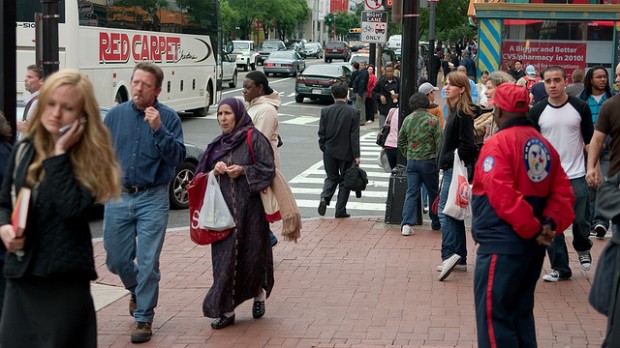The Disappearing Segregated City

Patrick Calder / Flickr
Chinatown D.C. attracts a diversity of people.
Racial segregation in American cities, including in D.C., is on the decline, but it still exists. The D.C. region is the sixth most segregated large metro area, according to a new study by the Manhattan Institute, a conservative think tank. Racial segregation in the D.C. region has been dropping since 2000, but at a slower pace than eight of the nine other cities on the list.
All-white urban neighborhoods have been nearly eradicated in the past few decades, according to the study’s authors, who examined census data from 1890 through 2010. Very few all-white neighborhoods exist today, and they’re mostly in rural areas or cities with a very small black population. In 1970, one-fifth of urban neighborhoods didn’t have a single black resident.
Black suburbanization (made possible in part by fair housing laws) has been a major driving force in increasing the racial diversity of America’s neighborhoods — that’s the case locally with communities such as Prince George’s County, which has attracted former D.C. residents — but immigration and gentrification have played roles as well. Some D.C. neighborhoods have experienced rapid change with an influx of new residents; Navy Yard went from 95 percent black to 31 percent black in 10 years, with redevelopment attracting new white residents and increasing the neighborhood’s total population by 50 percent.
Not every neighborhood has seen such rapid changes, though. “A more gradual process of racial change is occurring in the city’s northwest quadrant, where several neighborhoods have seen a 25 percent drop in the proportion of black residents over the past decade,” the authors note. “This area represents the forefront of a wave of gentrification that began in Georgetown some decades ago and has crept steadily eastward since.”
And then there are neighborhoods where there has been little to no change in racial makeup, according to the study. In 2000, 17 District neighborhoods that were home to about 46,000 people had populations that were more than 98 percent black. Ten years later, and the racial makeup of those neighborhoods has changed very little.
All of this has to do with residential segregation. It doesn’t say much about public spheres where diverse people may regularly congregate. Take Chinatown D.C., which attracts people of all stripes to its commercial core. But even if people of many races are working or hanging out in the same neighborhood — just as if they’re living in the same neighborhood– that doesn’t necessarily mean they’re having meaningful interactions with each other. Although it increases the chances that they could.
-
Nu




